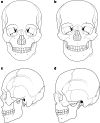Consensus on Changing Trends, Attitudes, and Concepts of Asian Beauty
- PMID: 26408389
- PMCID: PMC4819477
- DOI: 10.1007/s00266-015-0562-0
Consensus on Changing Trends, Attitudes, and Concepts of Asian Beauty
Abstract
Background: Asians increasingly seek non-surgical facial esthetic treatments, especially at younger ages. Published recommendations and clinical evidence mostly reference Western populations, but Asians differ from them in terms of attitudes to beauty, structural facial anatomy, and signs and rates of aging. A thorough knowledge of the key esthetic concerns and requirements for the Asian face is required to strategize appropriate facial esthetic treatments with botulinum toxin and hyaluronic acid (HA) fillers.
Methods: The Asian Facial Aesthetics Expert Consensus Group met to develop consensus statements on concepts of facial beauty, key esthetic concerns, facial anatomy, and aging in Southeastern and Eastern Asians, as a prelude to developing consensus opinions on the cosmetic facial use of botulinum toxin and HA fillers in these populations.
Results: Beautiful and esthetically attractive people of all races share similarities in appearance while retaining distinct ethnic features. Asians between the third and sixth decades age well compared with age-matched Caucasians. Younger Asians' increasing requests for injectable treatments to improve facial shape and three-dimensionality often reflect a desire to correct underlying facial structural deficiencies or weaknesses that detract from ideals of facial beauty.
Conclusions: Facial esthetic treatments in Asians are not aimed at Westernization, but rather the optimization of intrinsic Asian ethnic features, or correction of specific underlying structural features that are perceived as deficiencies. Thus, overall facial attractiveness is enhanced while retaining esthetic characteristics of Asian ethnicity. Because Asian patients age differently than Western patients, different management and treatment planning strategies are utilized.
Level of evidence v: This journal requires that authors assign a level of evidence to each article. For a full description of these Evidence-Based Medicine ratings, please refer to Table of Contents or the online Instructions to Authors www.springer.com/00266.
Keywords: Asian facial aging; Asian facial anatomy; Asian facial esthetics; Asian facial features; Consensus opinion; Facial injectables.
Figures



References
-
- Carruthers JD, Glogau RG, Blitzer A, Facial Aesthetics Consensus Group Faculty Advances in facial rejuvenation: botulinum toxin type A, hyaluronic acid dermal fillers, and combination therapies–consensus recommendations. Plast Reconstr Surg. 2008;121:5S–30S. doi: 10.1097/PRS.0b013e31816de8d0. - DOI - PubMed
-
- Rzany B, Fratila AA, Fischer TC, Hilton S, Pavicic T, Rothhaar A, Sattler G, Sommer B, Pickett A. Recommendations for the best possible use of botulinum neurotoxin type a (Speywood units) for aesthetic applications. J Drugs Dermatol. 2013;12:80–84. - PubMed
-
- Dessy LA, Fallico N, Mazzocchi M, Scuderi N. Botulinum toxin for glabellar lines: a review of the efficacy and safety of currently available products. Am J Clin Dermatol. 2011;12:377–388. - PubMed
-
- Raspaldo H, Baspeyras M, Bellity P, Dallara JM, Gassia V, Niforos FR, Belhaouari L, Consensus G. Upper- and mid-face anti-aging treatment and prevention using onabotulinumtoxin A: the 2010 multidisciplinary French consensus—part 1. J Cosmet Dermatol. 2011;10:36–50. doi: 10.1111/j.1473-2165.2010.00544.x. - DOI - PubMed
Publication types
MeSH terms
LinkOut - more resources
Full Text Sources
Other Literature Sources
Research Materials
Miscellaneous

